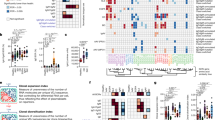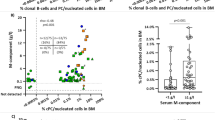Abstract
The incidence of B cell leukaemia in 186 consecutive untreated patients with histologically defined B cell neoplasms is described. The lymphomas were classified by the Kiel convention. B cell leukaemia in the context of this paper refers to the situation where a neoplastic clone of B cells in the blood greatly outnumbers normal blood B cells. It is defined as an absolute blood B cell count greater than 0.75 X 10(9)1(-1) where either greater than 90% B cells express kappa immunoglobulin light chains or greater than 80% express lambda light chains. This was found in several patients where the total blood lymphocyte count was within normal limits. All patients with diffuse lymphocytic lymphoma with the histological appearances of B cell chronic lymphocytic leukaemia (ML-BCLL) were found to have B cell leukaemia. However, more than half these patients had blood B cell counts less than 10 X 10(9)1(-1). B cell leukaemia was also a feature in approximately 33% of patients with follicle centre cell tumours and 33% of those with lymphoplasmacytoid tumours. B cell leukaemia was not detected in 34/35 patients with myelomatosis. The 35th patient had plasma cell leukaemia. Only 3/22 patients with high grade lymphoma had B cell leukaemia. In the three principal tumour types associated with B cell leukaemia mu + delta was the most common immunoglobulin heavy chain phenotype. Spontaneous mouse red cell rosette formation also characterised leukaemic B cells in these three groups but high proportions of mouse rosetting cells were seen only in association with ML-BCLL. None of 4 cases of prolymphocytic leukaemia showed mouse red cell rosetting. HLA-DR alpha chain was found on the leukaemic cells of all patients except one with ML-BCLL. B cell lymphopenia was a frequent finding in all histological groups in those patients who did not have B cell leukaemia.
This is a preview of subscription content, access via your institution
Access options
Subscribe to this journal
Receive 24 print issues and online access
$259.00 per year
only $10.79 per issue
Buy this article
- Purchase on Springer Link
- Instant access to full article PDF
Prices may be subject to local taxes which are calculated during checkout
Similar content being viewed by others
Rights and permissions
About this article
Cite this article
Cader, A., Richardson, P., Walsh, L. et al. The incidence of B cell leukaemia and lymphopenia in B cell neoplasia in adults: A study using the Kiel classification of non-Hodgkin's lymphoma. Br J Cancer 48, 185–193 (1983). https://doi.org/10.1038/bjc.1983.174
Issue Date:
DOI: https://doi.org/10.1038/bjc.1983.174



